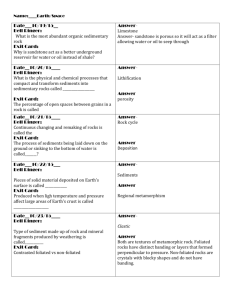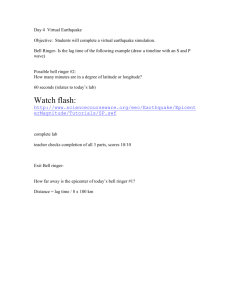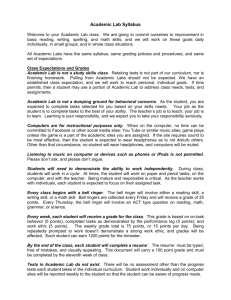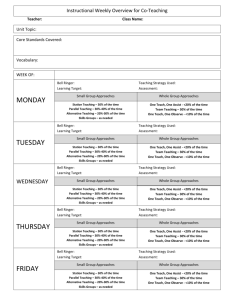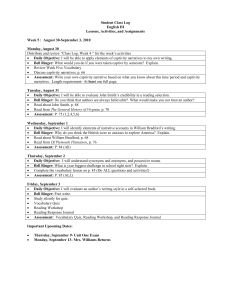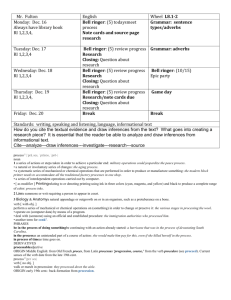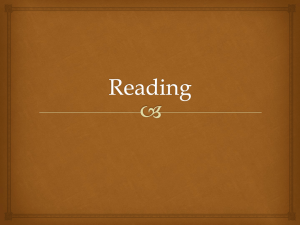Advanced Chemistry Problems: Gas Laws, Solutions, Thermo
advertisement
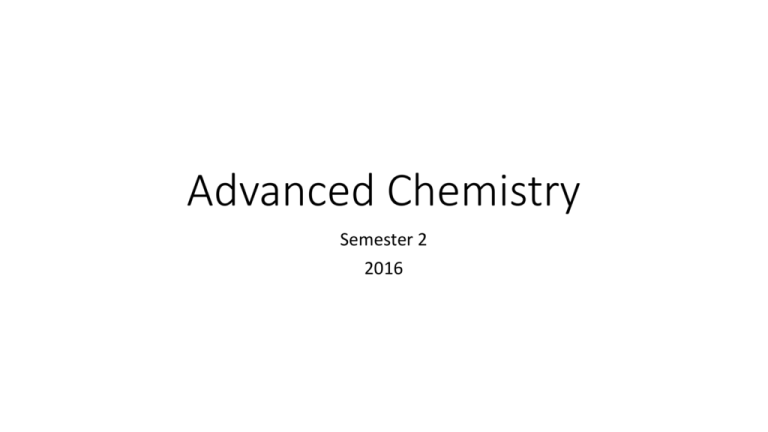
Advanced Chemistry Semester 2 2016 1-27-16 Bell Ringer Today you are beginning your write up for your STEAM Presentation… Your time can be used to: A) Research your potential topic B) Begin writing up your lab introduction using our Lab write up format from MT Tech C) Register on the STEAM website for your presentation April 2 (Sat 102:00). If you do not attend, you will be presenting to the class. Your oral grade will be based off your STEAM score. If in class, I will be your scorer. D) First person to show me where on our class webpage the handout for your lab write up is gets 5% etc added to their last exam 1-27-16 Exit We will be forming 2 lines…Stand across from your class BFF. Be prepared to share your research topic choice(s). When you share your choice, your friend will tell you a comment that will help you with your project. Acceptable comment examples: “What one variable are you isolating” or “Where will you get your materials” or any comment about the errors they might encounter and need to anticipate Unacceptable comment examples: “Cool idea Bro” or “I like your face” or anything not constructive in helping them with their topic 1-28-16 Bell Ringer Final Day of Research!!! Please type your Heading and Introduction if you have not started this component of your project. When complete, call Senger over to verify that you have these 2 portions started for points today. 1-28-16 Exit On a sheet of paper, please list anything you might need from Senger to complete this project. Examples: a day to type, any materials, a day to perform experiments etc. 1-29-16 Bell Ringer In a mixture of the major components of natural gas: CH4, C2H6, C3H8, and C4H10, which gas effuses the slowest and which the fastest? 1-29-16 Exit How much faster does F2 effuse than Cl2 at 25°C? 2-1-16 Bell Ringer The pressure on a sample of an ideal gas is increased from 715 mmHg to 3.55 atm at constant temperature. If the initial volume of the gas is 485 mL, what is the final volume of the gas? 2-1-16 Exit At what temperature will 1.00 mol of an ideal gas in a 1.00 L container exert a pressure of 1.00 atm? 2-2-16 Bell Ringer A 100.0 mL flask contains 0.193 g of a volatile oxide of nitrogen. The pressure in the flask is 760 mmHg at 17°C. Is the gas NO, NO2, or N2O5? 2-2-16 Exit Calculate the volume of carbon dioxide at 20°C and 1.00 atm produced from the complete combustion of 1.00 kg of methane. Compare your result with the volume of CO2 produced from the complete combustion of 1.00 kg of propane (C3H8). 2-3-16 Bell Ringer A gas mixture contains 0.70 mol N2, 0.20 mol H2, and 0.10 mol CH4. What is the mole fraction of H2 in the mixture? 2-3-16 Exit Ozone reacts completely with NO, producing NO2 and O2. A 2.50 L vessel is filled with 0.150 mol NO and 0.150 mol O3 at 125°C. What is the partial pressure of each product and the total pressure in the flask at the end of the reaction? 2-4-16 Bell Ringer The solubility of O2 in water is 6.5 mg/L at an atmospheric pressure of 1 atm and a temperature of 40°C. Calculate the Henry’s law constant of O2 at 40°C. 2-4-16 Exit Air is approximately 21% O2 and 78% N2 by mass. Calculate the root-mean-square speed of each gas at 273 K. 2-5-16 Bell Ringer Which noble gas is expected to deviate the most from ideal behavior in a graph of PV/RT versus P? 2-5-16 Exit Calculate the pressure exerted by 5.00 mol of CO2 in a 1.00 L vessel at 300 K (a) assuming the gas behaves ideally and (b) using the van der Waals equation. 1-8-16 Bell Ringer Calculate the lattice energy of sodium oxide (Na2O) from the following data: Ionization energy of Na(g) = 495 kJ/mol Electron affinity of O(g) for 2 electrons = 603 kJ/mol Energy to sublime Na(s) = 109 kJ/mol Bond energy of O2(g) = 498 kJ/mol ∆Hrxn for 2 Na(s) + 1/2 O2(g) → Na2O(s) = –416 kJ/mol 1-8-16 Exit Rank the compounds in Figure P11.16 in order of increasing vapor pressure at 298 K. 2-9-16 Bell Ringer Why does the boiling point of a mixture of volatile hydrocarbons increase over time during a distillation? 2-9-16 Exit A bottle is half-filled with a 50:50 (by moles) mixture of heptane (C7H16) and octane (C8H18) at 25°C. What is the mole ratio of heptane vapor to octane vapor in the air space above the liquid in the bottle? The vapor pressures of heptane and octane at 25°C are 31 torr and 11 torr, respectively. 2-10-16 Bell Ringer A solution contains 4.5 mol of water, 0.3 mol of sucrose (C12H22O11), and 0.2 mol of glucose. Sucrose and glucose are nonvolatile. What is the mole fraction of water in the solution? What is the vapor pressure of the solution at 35°C, given that the vapor pressure of pure water at 35°C is 42.2 torr? 2-10-16 Exit How many moles of solute are there in the following solutions? a. 0.150 m glucose solution made by dissolving the glucose in 100.0 kg of water b. 0.028 m Na2CrO4 solution made by dissolving the Na2CrO4 in 1000.0 g of water c. 0.100 m urea solution made by dissolving the urea in 500.0 g of water 2-11-16 Bell Ringer Cinnamon Cinnamon owes its flavor and odor to cinnamaldehyde (C9H8O). Determine the freezing point of a solution of 75 mg of cinnamaldehyde dissolved in 1.00 g of benzene (Kf = 4.3°C/m; normal freezing point = 5.5°C). 2-11-16 Exit Saccharin Determine the melting point of an aqueous solution made by adding 186 mg of saccharin (C7H5O3NS) to 1.00 mL of water (density = 1.00 g/mL, Kf = 1.86°C/m). 2-12-16 Bell Ringer How can measurements of osmotic pressure, freezing point depression, and boiling point elevation be used to find the molar mass of a solute? Why is it important to know whether the solute is an electrolyte or a nonelectrolyte? 2-12-16 Exit An unknown compound (152 mg) is dissolved in water to make 75.0 mL of solution. The solution does not conduct electricity and has an osmotic pressure of 0.328 atm at 27°C. Elemental analysis reveals the substance to be 78.90% C, 10.59% H, and 10.51% O. Determine the molecular formula of this compound. 2-16-16 Bell Ringer You have a mission…Please check with the substitute teacher to pick up your packets. In your packets, you will discover your partner(s), rubric for grading and responsibilities for your sections. Please refer to the lesson plan on our class webpage to stay current on your questions and homework. It is recommended that you create your presentation in Google Docs! (my daughter picked your teams by random draw out of a dog bowl so no whining) 2-16-16 Exit How do ion–dipole interactions influence whether an ionic compound’s heat of solution is exothermic or endothermic? 2-17-16 Bell Ringer The following pairs of aqueous solutions are separated by a semipermeable membrane. In which direction will the solvent flow? a. A = 0.48 M NaCl; B = 55.85 g of NaCl dissolved in 1.00 L of solution b. A = 100 mL of 0.982 M CaCl2; B = 16 g of NaCl in 100 mL of solution c. A = 100 mL of 6.56 mM MgSO4; B = 5.24 g of MgCl2 in 250 mL of solution 2-17-16 Exit Calculate the osmotic pressure of each of the following aqueous solutions at 27°C: a. 10.0 g of NaCl in 1.50 L of solution b. 10.0 mg/L of LiNO3 c. 0.222 M glucose d. 0.00764 M K2SO4 2-18-16 Bell Ringer Which one of the following aqueous solutions should have the lowest freezing point: 0.0500 m C6H12O6, 0.0300 m KBr, or 0.0150 m Na2SO4? 2-18-16 Exit Arrange the following solutions in order of increasing freezing point depression: a. 0.10 m MgCl2 in water, i = 2.7, Kf = 1.86°C/m b. 0.20 m toluene in diethyl ether, i = 1.00, Kf = 1.79°C/m c. 0.20 m ethylene glycol in ethanol, i = 1.00, Kf = 1.99°C/m 2-19-16 Bell Ringer Which aqueous solution has the highest boiling point: 0.5 m glucose, 0.5 m NaCl, or 0.5 m CaCl2? 2-19-16 Exit Determine the boiling point of an aqueous solution that is 2.50 m ethylene glycol (HOCH2CH2OH); Kb for water is 0.52°C/m. Assume that the boiling point of pure water is 100.00°C. 2-22-16 Bell Ringer You have 5 minutes to talk to your neighbor about any questions you might have on your chapters 10 & 11 learning log. Be prepared to grade your notebooks when the time is over. 2-22-16 Exit Share a half sheet of paper with your neighbor. 1) 2) 3) 4) Write the name(s) of your STEAM project group What have you completed so far? What is your next step? Is there anything you need from me to assist? Yes/No and if Yes what is it? 5) Are you presenting at STEAM April 2nd or are you presenting the following week in class? 2-23-16 Bell Ringer The three identical glass spheres in Figure P12.15 contain the same number of particles at the same temperature. Rank the containers in order of increasing number of microstates accessible to the particles inside them. (a) (b) FIGURE P12 .15 (c) 2-23-16 Exit Which of the following molecular solutes experience an increase in entropy when dissolved in water? (a) CO2(g), (b) HF(g), (c) CH3OH(ℓ), (d) CH3COOH(ℓ), (e) C12H22O11(s) 2-24-16 Bell Ringer Rank the compounds in each of the following groups in order of increasing standard molar entropy (S°): a. CH4(g), CH3CH3(g), and CH3CH2CH3(g) b. CCl4(ℓ), CHCl3(ℓ), and CH2Cl2(ℓ) c. CO2(ℓ), CO2(g), and CS2(g) 2-24-16 Exit Adding sidewalk deicer (calcium chloride) to water causes the temperature of the water to increase. If solid CaCl2 is the system, what are the signs of ∆Ssys and ∆Ssurr? 2-25-16 Bell Ringer What are the signs of ∆Ssys and ∆Suniv for the photosynthesis of glucose from carbon dioxide and water? 2-25-26 Exit Do decomposition reactions tend to have ∆S°rxn values that are greater than zero or less than zero? Why? 2-26-16 Bell Ringer Use the standard molar entropies in Appendix 4 to calculate the ∆S° value for each of the following reactions of sulfur compounds. a. H2S(g) + 3/2 O2(g) → H2O(g) + SO2(g) b. 2 SO2(g) + O2(g) → 2 SO3(g) c. SO3(g) + H2O(ℓ) → H2SO4(aq) d. S(g) + O2(g) → SO2(g) 1. if H is - and S is + G must be negative, so spontaneous 2. if H is + and S is - G must be positive, so nonspontaneous 3. if H is - and S is ...... G will be negative if TS is smaller than H ...... G will be positive if TS is bigger than H 4 if H is + and S is + ..... G will be positive if TS is smaller than H ..... G will be negative if TS is bigger than H 2-26-16 Exit Calculate the ∆S° value for the conversion of ozone to oxygen 2 O3(g) → 3 O2(g) in the absence of Cl atoms, and compare it with the ∆S° value in Problem 12.39. 2-29-16 Bell Ringer What does the sign of ∆G tell you about the spontaneity of a process? What does the sign of ∆G tell you about the rate of a reaction? 2-29-16 Exit Which of the following processes is/are spontaneous? a. A tornado forms. b. A broken cell phone fixes itself. c. You get an A in this course. d. Hot soup gets cold before it is served. 3-1-16 Bell Ringer The values of ∆H°rxn and ∆S°rxn for the reaction 2 NO(g) + O2(g) → 2 NO2(g) are –12 kJ and –146 J/K. a. b. Use these values to calculate ∆G°rxn at 298 K. Explain why the value of ∆S°rxn is negative. 3-1-16 Exit Use the appropriate ∆G°f data in Appendix 4 to calculate ∆G°rxn for the complete combustion of methanol: 2 CH3OH(g) + 3 O2(g) → 2 CO2(g) + 4 H2O(g) 3-2-16 Bell Ringer Are exothermic reactions spontaneous only at low temperature? Explain your answer. 3-2-16 Exit Volcanoes Deposits of elemental sulfur are often seen near active volcanoes. Their presence there may be due to the following reaction of SO2 with H2S: SO2(g) + 2 H2S(g) → 3/8 S8(s) + 2 H2O(g) Assuming the values of ∆H°rxn and ∆S°rxn do not change appreciably with temperature, over what temperature range is the reaction spontaneous? 3-3-16 Bell Ringer Which of the following reactions is spontaneous: (i) only at low temperatures; (ii) only at high temperatures; (iii) at all temperatures? a. 2 H2S(g) + 3 O2(g) → 2 H2O(g) + 2 SO2(g) b. SO2(g) + H2O2(ℓ) → H2SO4(ℓ) c. S(g) + O2(g) → SO2(g) 3-3-16 Exit Methane-Producing Bacteria Methanogenic bacteria convert liquid acetic acid (CH3COOH) into CO2(g) and CH4(g). a. Is this process endothermic or exothermic under standard conditions? b. Is the reaction spontaneous under standard conditions? 3-4-16 Bell Ringer What is urban smog & what can be done about it? 3-4-16 What is the effect of concentration on reaction rate? 3-7-16 Bell Ringer Catalytic Converters and Combustion Catalytic converters in automobiles combat air pollution by converting NO & CO into N2 & CO2: 2 CO(g) + 2 NO(g) → N2(g) + 2 CO2(g) a. How is the rate of formation of N2 related to the rate of consumption of CO? b. How is the rate of formation of CO2 related to the rate of consumption of NO? c. How is the rate of consumption of CO related to the rate of consumption of NO? 3-7-16 Exit Write expressions for the rate of formation of products and the rate of consumption of reactants in each of the following reactions: a. Cl2O2(g) → 2 ClO(g) b. N2O5(g) → NO2(g) + NO3(g) c. 2 INO(g) → I2(g) + 2 NO(g) 3-8-16 Bell Ringer Reducing Nitric Oxide Emissions from Power Plants Nitric oxide (NO) can be removed from gas-fired power-plant emissions by reaction with methane as follows: CH4(g) + 4 NO(g) → 2 N2(g) + CO2(g) + 2 H2O(g) Write an equation relating each of the following pairs of rates: a. The rate of formation of N2 to the rate of formation of CO2 b. The rate of formation of CO2 to the rate of consumption of NO c. The rate of consumption of CH4 to the rate of formation of H2O 3-8-16 Exit The chemistry of smog formation includes NO3 as an intermediate in several reactions. a. If ∆[NO3]/∆t is –2.2 × 105 mM/min in the following reaction, what is the rate of formation of NO2? NO3(g) + NO(g) → 2 NO2(g) b. What is the rate of change of [NO2] in the following reaction if ∆[NO3]/∆t is –2.3 mM/min? 2 NO3(g) → 2 NO2(g) + O2(g) 3-9-16 Bell Ringer Determine the overall order of the following rate laws and the order with respect to each reactant. a. Rate = k[A]2[B]1/2 b. Rate = k[A]2[B][C] c. Rate = k[A][B]3[C]1/2 3-9-16 Exit Compounds A and B react to give a single product, C. Write the rate law for each of the following cases and determine the units of the rate constant by using the units M for concentration and s for time: a. The reaction is first order in A and second order in B. b. The reaction is first order in A and second order overall. c. The reaction is independent of the concentration of A and second order overall. d. The reaction is second order in both A and B. 3-10-16 Bell Ringer Two reactions in which there is a single reactant have nearly the same magnitude rate constant. One is first order; the other is second order. a. If the initial concentrations of the reactants are both 1.0 mM, which reaction will proceed at the higher rate? b. If the initial concentrations of the reactants are both 2.0 M, which reaction will proceed at the higher rate? 3-10-16 Exit Hydroperoxyl Radicals in the Atmosphere During a smog event, trace amounts of many highly reactive substances are present in the atmosphere. One of these is the hydroperoxyl radical, HO2, which reacts with sulfur trioxide, SO3. The rate constant for the reaction 2 HO2(g) + SO3(g) → H2SO3(g) + 2 O2(g) at 298 K is 2.6 × 1011 M –1 s–1. The initial rate of the reaction doubles when the concentration of SO3 or HO2 is doubled. What is the rate law for the reaction? 3-11-16 Bell Ringer T (K) 203 213 223 233 243 k (M–1 s–1) 4.14 × 105 7.30 × 105 1.22 × 105 1.96 × 106 3.02 × 106 The rate constant for the reaction NO2(g) + O3(g) → NO3(g) + O2(g) was determined over a temperature range of 40 K, with the following results: a. b. Determine the activation energy for the reaction. Calculate the rate constant of the reaction at 300 K. 3-11-16 Exit What overall reaction consists of the following elementary steps? ClO–(aq) + H2O(ℓ) → HClO(aq) + OH–(aq) I–(aq) + HClO(aq) → HIO(aq) + Cl–(aq) OH–(aq) + HIO(aq) → H2O(ℓ) + IO–(aq) 3-14-16 Bell Ringer Mechanism of Ozone Destruction Ozone decomposes thermally to oxygen in the following reaction: 2 O3(g) → 3 O2(g) The following mechanism has been proposed: O3(g) → O(g) + O2(g) O(g) + O3(g) → 2 O2(g) The reaction is second order in ozone. What properties of the two elementary steps (specifically, relative rate and reversibility) are consistent with this mechanism? 3-14-16 Exit NO as a Catalyst for Ozone Destruction Explain why NO is a catalyst in the following two-step process that results in the depletion of ozone in the stratosphere: (1) NO(g) + O3(g) → NO2(g) + O2(g) (2) O(g) + NO2(g) → NO(g) + O2(g) Overall: O(g) + O3(g) → 2 O2(g) 3-15-16 Bell Ringer A mixture of 13CO, 12CO2, and O2 in a sealed reaction vessel was used to follow the reaction Analysis of the reaction mixture after 1 day revealed the presence of compounds with molar masses 28, 29, 32, 44, and 45 g/mol. Identify the compounds and account for their presence. 3-15-16 Exit At 700 K the equilibrium constant Kc for the gasphase reaction between NO and O2 forming NO2 is 8.7 × 106. The rate constant for the reverse reaction at this temperature is 0.54 M –1 s–1. What is the value of the rate constant for the forward reaction at 700 K? 3-16-16 Bell Ringer At 1045 K the partial pressures of an equilibrium mixture of H2O, H2, and O2 are 0.040, 0.0045, and 0.0030 atm, respectively. Calculate the value of the equilibrium constant Kp at 1045 K. 3-16-16 Exit Analyses of an equilibrium mixture of gaseous N2O4 and NO2 gave the following results: [NO2] = 4.2 × 10–3 M and [N2O4] = 2.9 × 10–3 M. What is the value of the equilibrium constant Kc for the following reaction at the temperature of the mixture? 3-17-16 Bell Ringer The equilibrium constant Kc for the following equilibrium is 6.0 × 104 at 500 K. What is the value of Kp for this same equilibrium at 500 K? 3-17-16 Exit 3-18-16 Bell Ringer 3-18-16 Exit At 650 K, the value of the equilibrium constant Kp for the ammonia synthesis reaction is 4.3 × 10–4. If a vessel contains a reaction mixture in which [N2] = 0.010 M, [H2] = 0.030 M, and [NH3] = 0.00020 M, will more ammonia form? 3-29-16 Bell Ringer Write the Kc expression for the following reaction: 3-29-16 Exit Which of the following equilibria will shift toward formation of more products if the volume of a reaction mixture at equilibrium increases by a factor of 2? 3-30-16 Bell Ringer 3-30-16 Exit Enough NO2 gas is injected into a cylindrical vessel to produce a partial pressure, PNO2, of 0.900 atm at 298 K. Calculate the equilibrium partial pressures of NO2 and N2O4, given 3-31-16 Bell Ringer 3-31-16 Exit 4-1-16 Bell Ringer STEAM is tomorrow…Is there anyone that needs anything before we go to set up Saturday? 4-1-16 Exit Draw for Slots for in class STEAM Presentations…Note half class period each for 3 days Monday 4-4-16 First Half Class Second Half Class Tuesday 4-5-16 Wednesday 4-6-16
